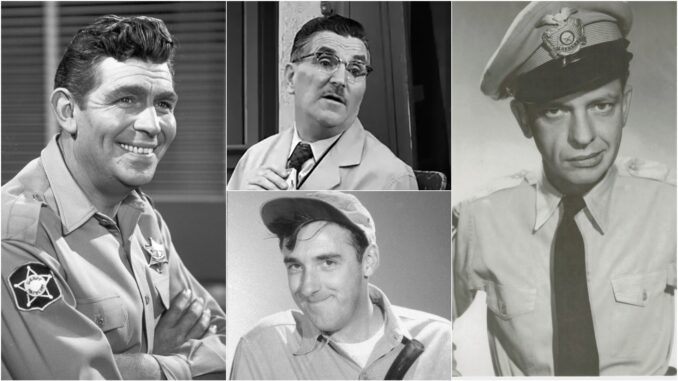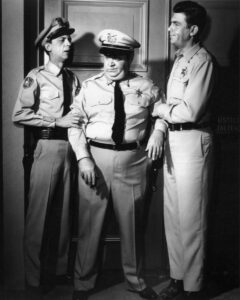
If you’ve ever watched The Andy Griffith Show, you probably cracked up at the small-town antics of Barney Fife or chuckled at Aunt Bee’s homemaking misadventures. But did you know that the man behind it all—Andy Griffith himself—actually had a rule against jokes? That’s right. According to Ron Howard, who played little Opie, Andy had a very specific comedy code: kill the joke if it’s too obvious.
It sounds counterintuitive, doesn’t it? A sitcom that avoids jokes? But it’s exactly this offbeat approach that turned The Andy Griffith Show into a timeless gem. Let’s dive deep into this surprising comedy philosophy, explore how it shaped the show’s tone, and unpack Ron Howard’s behind-the-scenes insights.
H1: The Heart of Mayberry—Where Comedy Was Quiet but Powerful
H2: Andy Griffith Didn’t Want Laughs for Laughs’ Sake
Andy Griffith’s approach was simple: Don’t try too hard to be funny. Ron Howard revealed that Andy would actively remove lines from the script if they seemed too desperate for laughs. If something sounded too much like a “setup-punchline” style of humor, Andy would say:
“Kill it. Don’t go for the laugh.”
And just like that, the line would be cut.
H3: Why Did Andy Kill the Jokes?
Andy wasn’t anti-comedy—far from it. But he understood something critical: authenticity is funnier than forced jokes. The laughs should come from the characters and their situations, not just punchlines. It was comedy that felt real, not rehearsed.
H1: Ron Howard’s Firsthand Account of Andy’s Comedy Philosophy
H2: Ron Howard Learned More Than Acting on Set
Being a child actor, Ron Howard grew up in the creative environment of The Andy Griffith Show. He later explained how working with Andy shaped his storytelling instincts. Howard said:
“Andy was wise about comedy. He understood that you could kill a scene by trying to make it too funny.”
That lesson stuck with him throughout his directing career.
H3: Subtle Over Slapstick
Ron’s experience revealed that the show’s genius lay in subtle humor, not slapstick gags. The comedy flowed from real emotions, awkward pauses, and character quirks, not rimshots and one-liners.

H1: The Show’s Balance Between Heart and Humor
H2: Mayberry Was About Real People, Not Comedians
Unlike other sitcoms of its time, The Andy Griffith Show wasn’t packed with “wise-cracking” characters. Even the funniest characters, like Barney Fife, weren’t telling jokes—they were the joke, in the most endearing way.
H3: Andy Played the Straight Man—On Purpose
Andy Griffith deliberately toned down his character’s comedy after the first season. Why? To let the supporting characters shine. By playing it straight, Andy became the steady anchor while others like Barney brought the laughs.
H1: The Writers Had to Adjust Their Style
H2: Writing for Mayberry Meant Writing for Andy’s Rules
Writers were often surprised when their funniest lines got cut. But over time, they learned that less was more. The goal was to create honest moments that reflected real life—where humor often comes from awkward silences, misunderstandings, or the everyday quirks of small-town life.
H3: Dialogue Over Delivery
Instead of joke-writing, writers focused on character-driven dialogue. The humor came naturally from the way characters interacted, not from throwing zingers.
H1: Don Knotts Was the Comedic Soul—but Even He Followed the Rule
H2: Barney Fife Was Funny Without Trying to Be
Don Knotts, who played Barney Fife, brought a wild energy to the show. But even he wasn’t allowed to “go for the laugh.” His humor worked because he was sincere, nervous, and over-the-top in character, not because he was cracking jokes.
H3: Timing, Not Punchlines
Knotts’ secret weapon? Timing. His nervous stammers and exaggerated body language made even the simplest line hilarious. But everything was still grounded in Andy’s rule—don’t force the comedy.
H1: A Comedy Rule That Influenced Future Generations
H2: Ron Howard Carried the Rule Into His Directing Career
You can see echoes of Andy’s philosophy in Howard’s later work. Whether it’s Parenthood, Apollo 13, or A Beautiful Mind, Howard prefers storytelling that feels natural and character-driven, rather than overproduced or overwritten.
H3: Modern Shows Still Take Notes from Mayberry
Shows like The Office and Parks and Recreation thrive on awkward humor and real emotions—tactics straight out of Mayberry’s playbook. They prove that “don’t go for the laugh” can still be the funniest approach.
H1: The Results Spoke for Themselves
H2: The Show’s Legacy Proves Andy Was Right
With eight seasons and a permanent spot in TV history, The Andy Griffith Show is still beloved today. That kind of staying power doesn’t happen by accident. Andy’s comedy rule gave the show its timeless tone, where the humor doesn’t age because it never relied on cheap jokes.
H3: A Show That Still Feels Fresh
Even today, episodes of The Andy Griffith Show don’t feel dated. Why? Because they’re not built around pop culture references or punchlines—they’re built around people, and people are timeless.
H1: Fans May Have Laughed, But They Were Also Touched
H2: Comedy with a Conscience
Mayberry wasn’t just funny—it was heartfelt. Whether it was Opie learning a lesson or Andy sharing a quiet moment with Aunt Bee, the show blended humor with humanity.
H3: The Best Sitcoms Make You Feel Something
It’s no coincidence that The Andy Griffith Show made people both laugh and tear up. That emotional range is what kept audiences coming back, episode after episode.
H1: Lessons from Mayberry for Today’s Creators
H2: Know When to Kill the Joke
It’s a strange but valuable lesson: sometimes, you have to cut the funniest line to protect the story. Today’s creators can learn from Andy’s method—if the joke distracts from the moment, it doesn’t belong.
H3: Build Real Characters First, Jokes Later
Comedy works best when it feels earned. Develop your characters first. Let their personalities and flaws do the heavy lifting. That’s what made Barney funny—and why we still quote him decades later.
H1: Final Thoughts—The Quiet Genius of Andy Griffith’s Rule
Who would’ve guessed that cutting jokes would make a sitcom one of the greatest of all time? Andy Griffith’s odd but brilliant rule turned The Andy Griffith Show into a masterclass in character-based comedy. And as Ron Howard’s testimony shows, that wisdom left a lasting mark—not just on viewers, but on generations of storytellers who came after.
FAQs
1. Why did Andy Griffith want to remove jokes from the show?
Andy felt that obvious jokes disrupted the natural tone of the show. He wanted humor to feel authentic and flow from character and situation, not punchlines.
2. Did the writers agree with Andy’s comedy rule?
At first, some were surprised. But over time, they adapted and understood that the show’s unique charm came from its grounded, character-driven humor.
3. Was The Andy Griffith Show considered a comedy or drama?
It was a sitcom, but it had strong elements of drama, heart, and emotional storytelling. That mix made it stand out from other shows of its time.
4. How did Don Knotts make his character funny without jokes?
Don Knotts used physical comedy, nervous energy, and precise timing to make Barney Fife hilarious—even without traditional jokes.
5. Is Andy Griffith’s comedy philosophy used in TV today?
Absolutely. Many modern shows that focus on character-based humor—like The Office or Ted Lasso—owe part of their DNA to Andy’s approach to comedy.
Let me know if you’d like an image, quote card, or tweet thread to promote this article!
